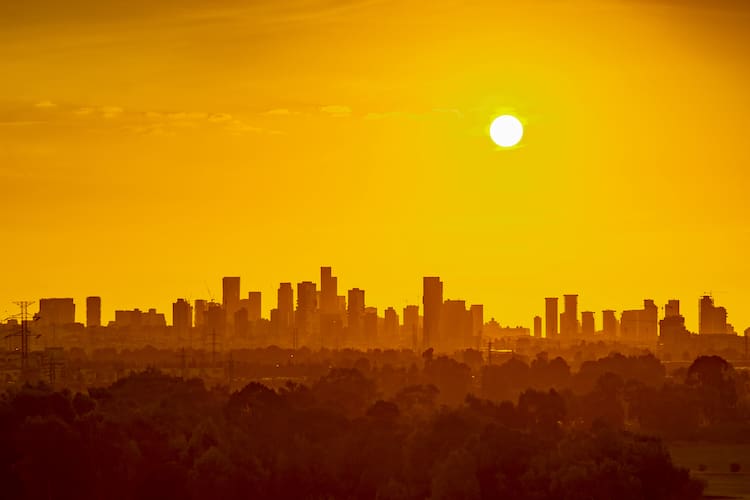
With climate change, cities in New England and beyond are experiencing longer and more frequent heat waves. But there are steps they can take to prepare.
In June, a vast heat dome scorched its way across large swaths of the country. Record-breaking triple-digit temperatures, centered in the South and Midwest, strained power grids and sent hundreds of overheated people to the hospital. In Texas alone, at least 13 people died.
So far this year in New England, we’ve largely escaped the extreme heat that’s seared the rest of the country. (Although forecasters are predicting a hotter-than-average July and August in some places.) But that doesn’t mean we shouldn’t prepare for the heat we know will eventually come our way. After all, in recent years, New England has broken heat records. Last year, according to NOAA, five out of six New England states experienced above-average temperatures year-round. In 2022, Concord, New Hampshire; Worcester, Massachusetts; Hartford, Connecticut; and Providence, Rhode Island, all sweltered through one of their warmest Augusts on record.
In addition, it turns out that two New England cities – Boston and Burlington – are among the nation’s top 15 cities for urban heat island effect. Heat islands are heavily paved and asphalted neighborhoods without much greenery, where temperatures can soar 15 to 20 degrees higher than in surrounding communities with vegetation. Often, these heat islands are in lower-income or communities of color where blistering heat puts children and older adults at risk.
So, the question we must ask ourselves, especially as the World Meteorological Organization warns us that the next five years may be the hottest the planet has ever experienced, is: Are we prepared? And if not, what can we do to offset the searing temperatures that make many urban neighborhoods intolerably and dangerously hot during heat waves?
There’s good news here. The answer is that there are proven, practical, and relatively easy strategies we can use right now to prepare for the next heat wave.
Step No. 1: Develop a heatwave response plan.
Right away, if they haven’t done so, cities need to protect the health of residents by creating a heat emergency response plan, including tapping existing social infrastructure – schools, places of worship, libraries, and community centers – to provide opportunities for residents to escape the heat. These community institutions can serve as “cooling centers” or “climate resilience hubs” that are physically centered in the neighborhood, offering amenities like air conditioning, and disseminating information and educational materials. They are especially critical in low-income communities where older adults may have no other recourse to beat the heat.
Well before temperatures rise, a multi-lingual public education and awareness campaign should also swing into action. Studies show that people are most at risk for health problems early in the season before they can acclimate to high heat and humidity, so getting the word out early is critical.
Step No. 2: Plant more trees and create green zones.
As cities refine their heat response plans, they can take another step today that will have a big payoff tomorrow: plant more trees. Trees planted as part of leafy, verdant green zones are an essential strategy in fostering climate resilience. Our “urban forests”– the trees in our parks, green spaces, and streets – do double duty when it comes to climate resilience. They soak up water during increasingly heavy rainstorms, which helps prevent flooding. And when temperatures rise, lush and leafy parks and street trees keep temperatures significantly lower. According to research, even a tiny green parcel, like a vacant lot or a patch of yard, can substantially lower heat. One Australian study found that tree canopy and small patches of grass lowered local daytime surface temperatures by up to 6 C on a very hot day. In addition, trees and parks help reduce carbon emissions by soaking up carbon dioxide. Plus, more planted trees and street vegetation will ultimately reduce electricity demand since residents in these areas stay cooler without blasting an air conditioner. That, in turn, improves the grid’s reliability when temperatures are high.
Step No. 3: Build with heat resilience in mind.
Re-tooling a city for heat resiliency will take time, but now that we know what the future holds, there is no question about what we need to do. Architects and urban planners know the materials and design tricks that keep buildings cool. So, let’s employ all those strategies by incorporating green and white roofs and “cool” pavements into our cities. Permeable pavements evaporate more water than traditional concrete and can be used for roads and parking lots. Roofs can be painted white to reflect heat rather than absorb it.
Cities should also encourage energy efficiency in buildings by incentivizing residents to sign up for efficiency programs centered on retrofitting buildings with improved insulation and state-of-the-art heat pumps. Transportation planners, too, should prioritize building protective sunshades at bus and train stops and laying down tracks that won’t buckle when the sun broils.
Public utilities and city and regional bodies should ensure that energy and water systems work and can handle the heat. When electricity demand soars with the temperature, it can lead to power outages – leaving residents even more vulnerable to heat-related illnesses and poor air quality.
Creating climate-resilient cities is not a mystery, and studies demonstrate that common-sense measures like these can make a dramatic difference.
It’s time to get smart. Let’s not wait to respond to a heat crisis in the literal heat of the moment.



